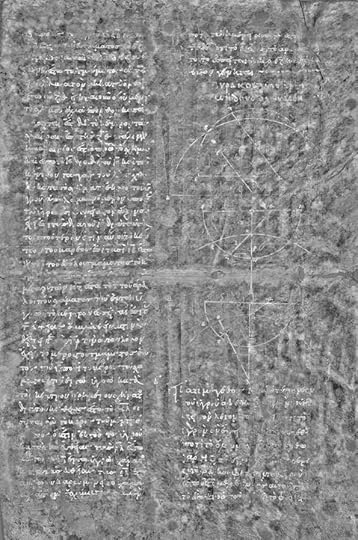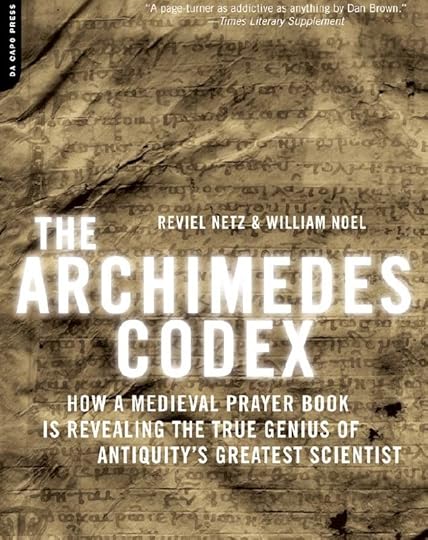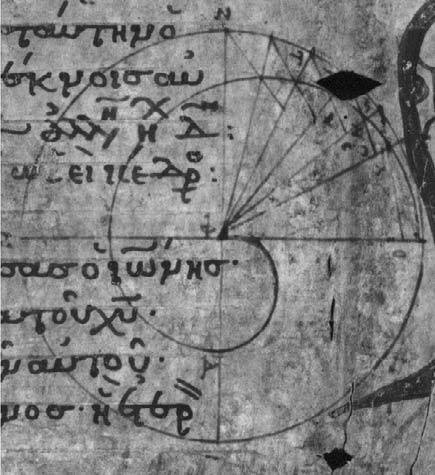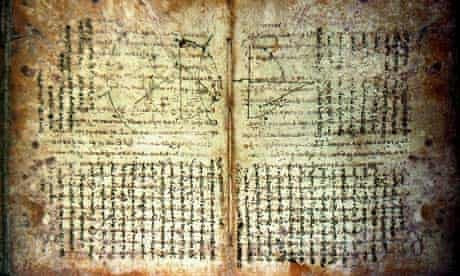THE ARCHIMEDES CODEX, Netz & Noel
ÎΩÎÎÎÎΣ ΤÎÎ¥ ÎΡΧÎÎÎÎÎΥΣ

ΠΡεβίλ ÎεÏÏ Î´ÎµÎ½ ÏίÏÏÎµÏ Îµ ÏÏα μάÏια ÏÎ¿Ï ÏÏαν άνοιξε Ïο e-mail ÏÎ¿Ï Î¼Î¹Î± μÎÏα ÏÎ¿Ï 1998. ÎαιÏÏ ÏÏÏα εÏοίμαζε μια νÎα μεÏάÏÏαÏη και ÎκδοÏη ÏÎ»Î¿Ï ÏÎ¿Ï ÎÏÎ³Î¿Ï ÏÎ¿Ï ÎÏÏιμήδη, και η ÏημανÏικÏÏεÏη Ïηγή κειμÎνÏν ÏÎ¿Ï ÏÎ¿Ï ÎλειÏε ήÏαν Îνα γνÏÏÏÏ Î±Î»Î»Î¬ ÏαμÎνο Î²Ï Î¶Î±Î½ÏÎ¹Î½Ï ÏαλίμÏηÏÏο. Το ηλεκÏÏÎ¿Î½Î¹ÎºÏ Î³Ïάμμα Îλεγε ÏÏι Ïο ÏολÏÏιμο Î±Ï ÏÏ ÏειÏÏγÏαÏο είÏε αίÏÎ½Î·Ï ÎµÎ¼ÏανιÏÏεί. Îαι ήÏαν ÎÏοιμο να βγει Ïε δημοÏÏαÏία ÏÏν ÎÏίÏÏÎ¹Ï ÏÏη ÎÎα Î¥ÏÏκη...ΣÏον ÎÏδικα ÏÎ¿Ï ÎÏÏÎ¹Î¼Î®Î´Î¿Ï Ï, ο ÎεÏÏ, μαζί με Ïον ÎÎ¿Ï Î¯Î»Î¹Î±Î¼ ÎοÎλ, ÎÏοÏο ÏÎ¿Ï Î¼Î¿Ï ÏÎµÎ¯Î¿Ï ÏÏο οÏοίο καÏÎληξε Ïο ÏαλίμÏηÏÏο μεÏά Ïην αγοÏά ÏÎ¿Ï ÎνανÏι 2.000.000 δολαÏίÏν αÏÏ Î¬Î³Î½ÏÏÏο ÏλειοδÏÏη (ÏημειÏÏÎον ÏÏι ÏÏη δημοÏÏαÏία ÏήÏε μÎÏÎ¿Ï ÏÏÏÎ¯Ï ÎµÏιÏÏ Ïία και Ïο ÎµÎ»Î»Î·Î½Î¹ÎºÏ ÎºÏάÏοÏ), ÏαÏÎ±ÎºÎ¿Î»Î¿Ï Î¸Î¿Ïν Ïο αÏίÏÏÎµÏ Ïο Ïαξίδι Î±Ï ÏÎ¿Ï ÏÎ¿Ï Î±ÏÏÎ±Î¯Î¿Ï ÎºÏδικα αÏÏ Ïη γÎννηÏή ÏÎ¿Ï Ï' Îνα μοναÏÏήÏι ÏÎ·Ï ÎÏνÏÏανÏινοÏÏÎ¿Î»Î·Ï ÎºÎ±Î¹ Ïην εξοÏία ÏÎ¿Ï ÏÏÎ¿Ï Ï ÎÎ³Î¯Î¿Ï Ï Î¤ÏÏÎ¿Ï Ï ÎºÎ±Î¹ ÏÏην εμÏÏλεμη ÎÏ ÏÏÏη, μÎÏÏι Ïην ÏÏÏÏÏαÏη εÏανεμÏάνιÏή ÏÎ¿Ï ÏÏÎ¹Ï ÎÎ Î. ΣÏη διαδÏομή Î±Ï Ïή, ÎÏονÏÎ±Ï Î±Î½Î±ÎºÏ ÎºÎ»Ïθεί Ïαν ÏÏοÏÎµÏ ÏηÏάÏιο γÏαμμÎνο ÏÎ¬Î½Ï ÏÏο αÏÏαίο κείμενο, Ï ÏÎÏÏη ÏοβαÏÎÏ ÏθοÏÎÏ ÎºÎ±Î¹ Îμεινε ξεÏαÏμÎνο Ïε Î²Î¹Î²Î»Î¹Î¿Î¸Î®ÎºÎµÏ ÎºÎ±Î¹ Ï ÏÏγεια. ΣήμεÏα, ÏάÏη Ïε μια ενÏÏ ÏÏÏιακή διεθνή ÏÏ Î½ÎµÏγαÏία ÏÎ¿Ï ÏεÏιλαμβάνει ÏÏ Î½ÏηÏηÏÎÏ ÏειÏογÏάÏÏν, ειδικοÏÏ ÏÎ·Ï Î·Î»ÎµÎºÏÏÎ¿Î½Î¹ÎºÎ®Ï Î±ÏεικÏνιÏηÏ, κλαÏικοÏÏ ÏιλολÏÎ³Î¿Ï Ï ÎºÎ±Î¹ ÏÏγÏÏÎ¿Î½Î¿Ï Ï Î¼Î±Î¸Î·Î¼Î±ÏικοÏÏ, Ïα ÏαμÎνα κείμενα και ÏÏεδιαγÏάμμαÏα ÏÎ¿Ï ÎÏÏιμήδη ÎÏÏονÏαι εÏιÏÎÎ»Î¿Ï Ï ÏÏο ÏÏÏ.ÎÏÏÏ ÏÏοκÏÏÏει αÏÏ Ïο βιβλίο, ÏμήμαÏα ÏÎ¿Ï ÎÏδικα ÏÎ¿Ï Î¼ÏÏÏεÏαν να διαβαÏÏοÏν για ÏÏÏÏη ÏοÏά δείÏÎ½Î¿Ï Î½ ÏÏι ο ÎÏÏÎ¹Î¼Î®Î´Î·Ï ÎµÎ¯Ïε μια ανÏίληÏη ÏÎ¿Ï "αÏείÏÎ¿Ï " ÏÎ¿Ï Î®Ïαν ÏÎ¿Î»Ï Î¼ÏÏοÏÏά αÏÏ Ïην εÏοÏή ÏÎ¿Ï , ήÏαν δε ο ÏÏÏÏÎ¿Ï Î¿ οÏÎ¿Î¯Î¿Ï Î±ÏÏολήθηκε ÏοβαÏά με Ïη ÏÏ Î½Î´Ï Î±ÏÏική. ÎÏÏÏ Ï ÏοÏÏηÏίζει ο ÎεÏÏ, αν Ïο μαθημαÏÎ¹ÎºÏ ÏÎ¿Ï ÎÏγο, ÏÎ¿Ï ÏÏÏα αÏοκαλÏÏÏεÏαι Ï' Ïλο ÏÎ¿Ï Ïο εÏÏÎ¿Ï ÎºÎ±Î¹ Ïο βάθοÏ, ÏÏοÏÏεθεί ÏÏÎ¹Ï Ïιο γνÏÏÏÎÏ ÏÏ Î¼Î²Î¿Î»ÎÏ ÏÎ¿Ï ÏÏη ÏÏ Ïική και Ïη μηÏανική, γίνεÏαι ολοÏάνεÏο ÏÏι ο ÎÏÏÎ¹Î¼Î®Î´Î·Ï ÎµÎ¯Î½Î±Î¹ "Î Î ÎΠΣÎÎÎÎΤÎÎÎΣ ÎÎ ÎΣΤÎÎΩΠΠÎÎ¥ ÎÎÎΣΠΠÎΤÎ". " ... ΠκαÏάÏÏαÏη ÏÎ¿Ï ÏειÏογÏάÏÎ¿Ï Î´ÎµÎ½ είναι καθÏÎ»Î¿Ï ÎºÎ±Î»Î®. ΣÏην ÏÏαγμαÏικÏÏηÏα η καÏάÏÏαÏή ÏÎ¿Ï Î®Ïαν κακή ήδη Ïην εÏοÏή ÏÎ¿Ï Ïο μελÎÏηÏε για ÏÏÏÏη ÏοÏά ο ΧάινμÏεÏγκ, ÏÏÎ¹Ï Î±ÏÏÎÏ ÏÎ¿Ï 20Î¿Ï Î±Î¹Ïνα ... ΣήμεÏα ÏμÏÏ Ïο ÏειÏÏγÏαÏο διαβάÏÏηκε ÏÏο ÏÏÎ½Î¿Î»Ï ÏÎ¿Ï , ÏάÏη ÏÏη βοήθεια ÏÎ¿Ï ÏÏÏÏÏεÏε η ÏÏγÏÏονη ÏεÏνολογία. ΧÏηÏιμοÏοιήθηκε ÎÎ½Î±Ï ÏÏ Î½Î´Ï Î±ÏμÏÏ Î´Î¹Î±ÏÏÏÏν ÏεÏνικÏν. ÎξελιγμÎÎ½ÎµÏ ÏεÏνικÎÏ ÏηÏÎ¹Î±ÎºÎ®Ï ÏÏÏογÏάÏηÏÎ·Ï (ÏÎ¿Î»Ï ÏαÏμαÏική αÏεικÏνιÏη, αÏεικÏνιÏη ÏθοÏιÏÎ¼Î¿Ï Î±ÎºÏίνÏν Χ), ÏεÏνικÎÏ ÎµÏεξεÏγαÏÎ¯Î±Ï ÎºÎ±Î¹ βελÏιÏÏοÏοίηÏÎ·Ï ÏÎ·Ï ÏηÏÎ¹Î±ÎºÎ®Ï ÎµÎ¹ÎºÏναÏ, ÎµÎ½Ï ÏÏεδιάÏÏηκε και Îνα ÎµÎ¹Î´Î¹ÎºÏ Î»Î¿Î³Î¹ÏÎ¼Î¹ÎºÏ Î±Î½Î±Î³Î½ÏÏίÏεÏÏ ÏαÏακÏήÏÏν (ÎCR) ... ΤÏία αÏÏ Ïα εÏÏά κείμενα ÏÎ¿Ï ÎÏÏιμήδη ÏÎ¿Ï ÏεÏιÎÏει Ïο ÏαλίμÏηÏÏο δεν Î±Î½ÎµÏ ÏίÏκονÏαι Ïε κανÎνα άλλο αÏÏ Ïα γνÏÏÏά ÏειÏÏγÏαÏα ÏÎ¿Ï ÎÏÏιμήδη, και Î±Ï ÏÏ Î±ÎºÏιβÏÏ ÎµÎ¯Î½Î±Î¹ ÏÎ¿Ï ÎºÎ±Î¸Î¹ÏÏά ανεκÏίμηÏη Ïην αξία ÏÎ¿Ï . Îν δεν Ï ÏήÏÏε Ïο ÏαλίμÏηÏÏο, δεν θα γνÏÏίζαμε Ïα εν λÏÎ³Ï ÎÏγα ÏÎ¿Ï ÎÏÏιμήδη και εÏομÎνÏÏ Î· εικÏνα ÏÎ¿Ï Î¸Î± είÏαμε για Ïην εÏιÏÏημονική ÏÏοÏÏÏικÏÏηÏά ÏÎ¿Ï Î¸Î± ήÏαν ÏεÏιοÏιÏμÎνη και αÏελήÏ." (ÎÏÏ Ïην ÏαÏÎ¿Ï ÏίαÏη ÏÎ·Ï ÎµÎºÎ´ÏÏεÏÏ ÏÎ·Ï Î ÎÎÎΤÎÎÎΣ)

Î Îγγλική ÎκδοÏη (AMAZON 2007) αναÏÎÏει Ïον ÎÏÏιμήδη ÏÏ 'Ïον μεγαλÏÏεÏο ÎαθημαÏÎ¹ÎºÏ ÏÎ¿Ï Î±ÏÏÎ±Î¯Î¿Ï ÎºÏÏÎ¼Î¿Ï ' και 'Îναν αÏÏ ÏÎ¿Ï Ï Î¼ÎµÎ³Î±Î»ÏÏεÏÎ¿Ï Ï Î´Î¹Î±Î½Î¿Î·ÏÎÏ ÏÎ¿Ï ÎζηÏαν ÏοÏÎ' (ÏÏÏλογοÏ, Ïελ. 1). ΦαίνεÏαι ÏÏι η ÎκδοÏη ÏÎ·Ï Î ÎÎÎΤÎÎÎÏ ÏÏÏÏοÏÏÏηÏε ονομαζονÏÎ¬Ï Ïον "Î Î ÎΠΣÎÎÎÎΤÎÎÎΣ ÎÎ ÎΣΤÎÎΩΠΠÎÎ¥ ÎÎÎΣΠΠÎΤÎ" ÏÏάÏη ÏÎ¿Ï ÏÏάγμαÏι εξεÏÏÏμιÏε ο ÏÏ Î³Î³ÏαÏÎÎ±Ï ÏÏην Ïελ. 284! ..
ΠΡÎΣÎÎÎÎ Î: ΦαίνεÏαι ÏÏι κάÏοια ÏÏιγμή νÏÏÎ¯Ï ÏÏÎ¹Ï Î±ÏÏÎÏ ÏÎ¿Ï ÎÏÎ¿Ï Ï 1229, ÎÎ»Î»Î·Î½Î±Ï Î¹ÎµÏÎαÏ, ονÏμαÏι ÎÏÎ¬Î½Î½Î·Ï ÎÏÏÏναÏ, ÏÏειάÏÏηκε ÏεÏγαμηνή για Îνα βιβλίο ÏÏοÏÎµÏ ÏήÏ, ÏήÏε λοιÏÏν μία ÏÏ Î»Î»Î¿Î³Î® ÎÏγÏν ÏÎ¿Ï ÎÏÏÎ¹Î¼Î®Î´Î¿Ï Ï ÏÎ¿Ï Î®Ïαν γÏαμμÎνη Ïε ÏεÏγαμηνή ÏεÏίÏÎ¿Ï 250 ÏÏÏνια νÏÏίÏεÏα και διÎγÏαÏε, ÏÏο καλÏÏεÏα μÏοÏοÏÏε, Ïο κείμενο ÏÎ¿Ï ÎÏÏÎ¹Î¼Î®Î´Î¿Ï Ï Î±ÏÏ ÎµÎºÎµÎ¯Î½ÎµÏ ÏÏν ÏελίδÏν ÏÎ¿Ï ÏÎ¿Ï Î®Ïαν ακÏμη ÏÏήÏιμεÏ. ÎÏ ÏÏÏ ÎµÎ½ ÏÏ Î½ÎµÏεία ÏÏηÏιμοÏοίηÏε Î±Ï ÏÎÏ ÏÎ¹Ï ÏÎµÎ»Î¯Î´ÎµÏ Î³Î¹Î± να γÏάÏει Ïο κείμενο Î¼Î¹Î±Ï ÏÏ Î»Î»Î¿Î³Î®Ï ÎµÎ»Î»Î·Î½Î¹ÎºÏν ÏÏοÏÎµÏ ÏÏν Ïε οÏθή γÏνία ÏÏÏÏ Ïο ÎÏÏιμήδειο κείμενο αÏÏ ÎºÎ¬ÏÏ. ΣÏην ÏÏαγμαÏικÏÏηÏα ÏμÏÏ Î¿ ÎÏÏÏÎ½Î±Ï ÏÏειαζÏÏαν ÏεÏιÏÏÏÏεÏη ÏεÏγαμηνή αÏÏ Ï, Ïι θα μÏοÏοÏÏε να ÏÏοÏÏÎÏει ο ÏαλιÏÏ ÎÏÏÎ¹Î¼Î®Î´ÎµÎ¹Î¿Ï ÎºÏδικαÏ, οÏÏÏε εÏενÎβη καÏά Ïον ίδιο ÏÏÏÏο και Ïε άλλα εÏίÏÎ·Ï ÏημανÏικά και ÏÏÏα ÏαμÎνα, κείμενα ..... (Îλλά Î±Ï Ïή είναι μια άλλη ιÏÏοÏία.)[5]
ΠΡÎΣÎÎÎÎ Î': âThe safest general characterization of the European scientific tradition is that it consists of a series of footnotes to Archimedes.â ή "ΠαÏÏαλÎÏÏεÏÎ¿Ï Î³ÎµÎ½Î¹ÎºÏÏ ÏαÏακÏηÏιÏμÏÏ ÏÎ·Ï ÎµÏ ÏÏÏαÏÎºÎ®Ï ÎµÏιÏÏÎ·Î¼Î¿Î½Î¹ÎºÎ®Ï ÏαÏαδÏÏεÏÏ ÎµÎ¯Î½Î±Î¹ ÏÏι ÏÏ Î½Î¯ÏÏαÏαι αÏÏ Î¼Î¯Î± ÏειÏά Ï ÏοÏημειÏÏεÏν ÏÏον ÎÏÏιμήδη."
ÎÎÎ ÎΡΩΤÎÎÎ: ΦανÏάζεÏÏε - ÏÏÏÏ Î¸Î± ÏÏοÏιμοÏÏα και ÎµÎ³Ï ÎºÎ±Ï' αÏÏήν - Ïο ÏαλίμÏηÏÏο να αγοÏαζÏÏαν ÏελικÏÏ Î±ÏÏ Ïο 'ÎλληνικÏ' ÎημÏÏιο και να ανεÏίθεÏο η μελÎÏη ÏÎ¿Ï Ï.Ï. ÏÏον κ. Î ÎÎÎΤÎÎ ? ÎÏÎ¿Ï ÎºÎ±Î¹ να ανεÏίθεÏο Î¿Ï Î´ÎµÎ¯Ï ÎλληνÏÏÏÎ½Î¿Ï ÎºÎ±Î¸Î·Î³Î·ÏÎ®Ï Î´ÎµÎ½ θα αÏοÏολμοÏÏε να γÏάÏει ÏÏι ÎγÏαÏαν οι ÎÏÏαηλινoί ειδικοί Netz & Noel .. Σε Ïλην Ïην ομάδα ÏÏÏÏÏάμε Ïολλά ..
ΠΡÎΣÎÎÎÎ Î': The Newtonian program of reducing physical systems to geometrical representations obeying mathematical laws was taken from the Archimedean blueprint for science.And so, without Archimedes, there would be neither Galileo nor Newton. And for that matter, there would be no Boltzmann or Shannon either. Το ÎÎµÏ ÏÏνειο ÏÏÏγÏαμμα αναγÏÎ³Î®Ï ÏÏν ÏÏ ÏικÏν ÏÏ ÏÏημάÏÏν Ïε γεÏμεÏÏικÎÏ Î±Î½Î±ÏαÏαÏÏάÏÎµÎ¹Ï Î¿Î¹ οÏÎ¿Î¯ÎµÏ Ï ÏακοÏÎ¿Ï Î½ Ïε μαθημαÏικοÏÏ Î½ÏÎ¼Î¿Ï Ï ÏÏοήλθε αÏÏ Ïο ÏÏÎδιο ÏÎ¿Ï ÎÏÏÎ¹Î¼Î®Î´Î¿Ï Ï Î³Î¹Î± Ïην εÏιÏÏήμη. Îαι ÎÏÏι, ÏÏÏÎ¯Ï Ïον ÎÏÏιμήδη, δεν θα Ï ÏήÏÏε κανÎÎ½Î±Ï Galileo οÏÏε Newton, οÏÏε Boltzmann or Shannon .. [10]

ÎÎÎÎ ÎÎÎÎΣÎÎΥΣÎ: Archimedes is the most important scientist who ever lived. This conclusion can be reached as follows.The British philosopher A. N. Whitehead once famously remarked: âThe safest general characterization of the European philosophical tradition is that it consists of a series of footnotes to Plato.â This judgment may sound outrageous, but in fact it is quite sober minded. Platoâs immediate followers, such as Aristotle, tried above all to refute or to refine Platoâs arguments.Later philosophers debated whether it was best to follow Plato or Aristotle. And so, in a real sense, all later Western philosophy is but a footnote to Plato.The safest general characterization of the European scientific tradition is that it consists of a series of footnotes to Archimedes. By which I mean, roughly the same kind of genealogy that Whitehead meant for Plato applies to Archimedes. As an example, we need only to look at one of the most influential books of modern science, Galileoâs Discourses Concerning Two New Sciences. This book was published in 1638, by which time Archimedes had been dead for exactly 1,850 yearsâa very long time indeed.Yet throughout it, Galileo is in debt to Archimedes. Essentially, Galileo advances the two sciences of statics (how objects behave in rest) and dynamics (how objects behave in motion). For statics, Galileoâs principal tools are centers of gravity and the law of the balance. Galileo borrows both of these conceptsâ explicitly, always expressing his admirationâfrom Archimedes. For dynamics, Galileoâs principal tools are the approximation of curves and the proportions of times and motions. Both of which, once again, derive directly from Archimedes. No other authority is as frequently quotedor quoted with equal reverence. Galileo essentially started out from where Archimedes left off, proceeding in the same direction as defined by his Greek predecessor.This is true not only of Galileo but also of the other great figures of the so-called âscientific revolution,â such as Leibniz, Huygens, Fermat, Descartes, and Newton. All of them were Archimedesâ children.With Newton, the science of the scientific revolution reached its perfection in a perfectly Archimedean form. Based on pure, elegant first principles and applying pure geometry, Newton deduced the rules governing the universe. All of later science is a consequence of the desire to generalize Newtonian, that is, Archimedean methods.The two principles that the authors of modern science learned from Archimedes are:⢠The mathematics of infinity⢠The application of mathematical models to the physicalworldThanks to the Palimpsest,we now know much more about these two aspects of Archimedesâ achievement.
ΣΤÎÎ ÎÎÎÎÎÎÎÎ (κÏιÏική καλοδεÏοÏμενη ..): Î ÎÏÏÎ¹Î¼Î®Î´Î·Ï ÎµÎ¯Î½Î±Î¹ ο Ïιο ÏημανÏικÏÏ ÎµÏιÏÏήμÏν ÏÎ¿Ï ÎζηÏε ÏοÏÎ. ÎÏ ÏÏ Ïο ÏÏ Î¼ÏÎÏαÏμα μÏοÏεί να ÏÏ Î½Î±Ïθεί ÏÏ ÎµÎ¾Î®Ï. Î ÎÏεÏανÏÏ ÏιλÏÏοÏÎ¿Ï A. N. Whitehead κάÏοÏε Ï ÏεÏÏήÏιξε: "ΠαÏÏαλÎÏÏεÏÎ¿Ï Î³ÎµÎ½Î¹ÎºÏÏ ÏαÏακÏηÏιÏμÏÏ ÏÎ·Ï ÎµÏ ÏÏÏαÏÎºÎ®Ï ÏιλοÏοÏÎ¹ÎºÎ®Ï ÏαÏαδÏÏεÏÏ ÎµÎ¯Î½Î±Î¹ ÏÏι Î±Ï Ïή ÏÏ Î½Î¯ÏÏαÏαι αÏÏ Î¼Î¹Î± ÏειÏά Ï ÏοÏημειÏÏεÏν ÏÏον ΠλάÏÏνα." ÎÏ ÏÏ Ïο αÏÏÏθεγμα μÏοÏεί να ακοÏγεÏαι εξÏÏÏενικÏ, αλλά ÏÏην ÏÏαγμαÏικÏÏηÏα είναι αÏοÏÎλεÏμα ÏÏÎ¯Î¼Î¿Ï ÏκÎÏεÏÏ. Îι άμεÏοι οÏαδοί ÏÎ¿Ï Î Î»Î¬ÏÏνοÏ, ÏÏÏÏ Î¿ ÎÏιÏÏοÏÎληÏ, ÏÏοÏÏάθηÏαν ÎºÏ ÏίÏÏ Î½Î± ανÏικÏοÏÏÎ¿Ï Î½ ή να βελÏιÏÏÎ¿Ï Î½ Ïα εÏιÏειÏήμαÏά ÏÎ¿Ï . ÎÏγÏÏεÏα οι ÏιλÏÏοÏοι ÏÏ Î¶Î®ÏηÏαν εάν ήÏαν καλλίÏεÏο ÎºÎ±Î½ÎµÎ¯Ï Î½Î± Î±ÎºÎ¿Î»Î¿Ï Î¸Î®Ïει Ïον ΠλάÏÏνα ή Ïον ÎÏιÏÏοÏÎλη. Îαι ÎÏÏι, Ï ÏÏ Î±Ï Ïήν Ïην Îννοια, Ïλη η μεÏαγενÎÏÏεÏη Î´Ï Ïική ÏιλοÏοÏία είναι μÏνον μια Ï ÏοÏημείÏÏη ÏÏον ΠλάÏÏνα.ΠαÏÏαλÎÏÏεÏÎ¿Ï Î³ÎµÎ½Î¹ÎºÏÏ ÏαÏακÏηÏιÏμÏÏ ÏÎ·Ï ÎµÏ ÏÏÏαÏÎºÎ®Ï ÎµÏιÏÏÎ·Î¼Î¿Î½Î¹ÎºÎ®Ï ÏαÏαδÏÏεÏÏ ÎµÎ¯Î½Î±Î¹ ÏÏι αÏοÏελείÏαι αÏÏ Î¼Î¹Î± ÏειÏά Ï ÏοÏημειÏÏεÏν ÏÏον ÎÏÏιμήδη. Îε Î±Ï ÏÏ ÎµÎ½Î½Î¿Ï, ÏεÏίÏÎ¿Ï Ïο ίδιο ÎµÎ¯Î´Î¿Ï Î³ÎµÎ½ÎµÎ±Î»Î¿Î³Î¯Î±Ï ÏÎ¿Ï Î¿ Whitehead διαÏÏÏÏÏε για Ïον ΠλάÏÏνα και ιÏÏÏει εÏίÏÎ·Ï Î³Î¹Î± Ïον ÎÏÏιμήδη. Îια ÏαÏάδειγμα, ÏÏειάζεÏαι μÏνο να δοÏμε Îνα αÏÏ Ïα ÏλÎον ÏημανÏικά βιβλία ÏÎ·Ï ÏÏγÏÏÎ¿Î½Î·Ï ÎµÏιÏÏήμηÏ, Ïο Discourses Concerning Two New Sciences [ÏÏαγμαÏεία εÏι ÏÎ·Ï Î¦Ï ÏÎ¹ÎºÎ®Ï Ï ÏÏ Ïην μοÏÏή διαλÏγÏν] ÏÎ¿Ï Galileo. ÎÏ ÏÏ Ïο βιβλίο εκδÏθηκε Ïο 1638, ÏÏαν ο ÎÏÏÎ¹Î¼Î®Î´Î·Ï ÎµÎ¯Ïε ήδη Ïεθάνει ÏÏιν 1.850 ÏÏÏνια - ÏÏάγμαÏι ÏÎ¿Î»Ï ÎºÎ±Î¹ÏÏ. ΩÏÏÏÏο, Ïε Ïλο Î±Ï ÏÏ Ïο ÎÏγο, ο ÎÎ±Î»Î¹Î»Î±Î¯Î¿Ï Î±Î½Î±Î³Î½ÏÏίζει Ïην οÏειλή ÏÎ¿Ï ÏÏον ÎÏÏιμήδη, Ïην οÏοίαν εκÏÏάζει ÏηÏά. ÎÏ ÏιαÏÏικά, ο ÎÎ±Î»Î¹Î»Î±Î¯Î¿Ï ÏÏοάγει ÏÎ¹Ï Î´Ïο εÏιÏÏÎ®Î¼ÎµÏ ÏÎ·Ï Î£Î¤ÎΤÎÎÎΣ (ÏÏÏ ÏÏ Î¼ÏεÏιÏÎÏονÏαι Ïα ÏÏμαÏα εν ηÏεμία) και ÏÎ·Ï ÎÎ¥ÎÎÎÎÎÎΣ (ÏÏÏ Ïα ανÏικείμενα ÏÏ Î¼ÏεÏιÏÎÏονÏαι εν κινήÏει). Îια Ïην ÏÏαÏική, κÏÏια εÏγαλεία ÏÎ·Ï Î±Î½Î±Î»ÏÏεÏÏ ÏÎ¿Ï ÎÎ±Î»Î¹Î»Î±Î¯Î¿Ï ÎµÎ¯Î½Î±Î¹ Ïο κÎνÏÏο βάÏÎ¿Ï Ï ÎºÎ±Î¹ ο νÏÎ¼Î¿Ï ÏÎ·Ï Î¹ÏοÏÏοÏίαÏ. Î ÎÎ±Î»Î¹Î»Î±Î¯Î¿Ï Î´Î±Î½ÎµÎ¯Î¶ÎµÏαι και ÏÎ¹Ï Î´Ïο Î±Ï ÏÎÏ ÎÎ½Î½Î¿Î¹ÎµÏ - ÏÏ Î»Î»Î®ÏειÏ, εκÏÏάζονÏÎ±Ï ÏάνÏα Ïον Î¸Î±Ï Î¼Î±ÏÎ¼Ï ÏÎ¿Ï - αÏÏ Ïον ÎÏÏιμήδη. Îια Ïη Î´Ï Î½Î±Î¼Î¹ÎºÎ®, Ïα κÏÏια εÏγαλεία ÏÎ¿Ï ÎÎ±Î»Î¹Î»Î±Î¯Î¿Ï ÎµÎ¯Î½Î±Î¹ η ÏÏοÏÎγγιÏη ÏÏν καμÏÏ Î»Ïν και η αναλογία ÏÏν ÏÏÏνÏν και ÏÏν κινήÏεÏν. Îαι Ïα δÏο, για άλλη μια ÏοÏά, ÏÏοÎÏÏονÏαι αÏÎµÏ Î¸ÎµÎ¯Î±Ï Î±ÏÏ Ïον ÎÏÏιμήδη. Îαμμία άλλη Î±Ï Î¸ÎµÎ½Ïία - ÏÎÏαν Î±Ï ÏÎ®Ï ÏÎ¿Ï ÎÏÏÎ¹Î¼Î®Î´Î¿Ï Ï - δεν αναÏÎÏεÏαι ÏÏÏο ÏÏ Ïνά οÏÏε ÏαίÏει ίÏÎ¿Ï ÏεβαÏμοÏ. Î ÎÎ±Î»Î¹Î»Î±Î¯Î¿Ï Î¿Ï ÏιαÏÏικά ξεκίνηÏε αÏÏ ÎµÎºÎµÎ¯ ÏÎ¿Ï ÏÏαμάÏηÏε ο ÎÏÏιμήδηÏ, ÏÏοÏÏÏÏνÏÎ±Ï ÏÏÎ¿Ï Ïην ίδια καÏεÏÎ¸Ï Î½Ïη ÏÏÏÏ Î¿ÏίÏÏηκε αÏÏ Ïον Îλληνα ÏÏοκάÏοÏÏ ÏÎ¿Ï . ÎÏ ÏÏ Î¹ÏÏÏει ÏÏι μÏνον για Ïο Îαλιλαίο αλλά και για ÏÎ¹Ï Î¬Î»Î»ÎµÏ Î¼ÎµÎ³Î¬Î»ÎµÏ ÏÏοÏÏÏικÏÏηÏÎµÏ ÏÎ·Ï Î»ÎµÎ³ÏÎ¼ÎµÎ½Î·Ï 'εÏιÏÏÎ·Î¼Î¿Î½Î¹ÎºÎ®Ï ÎµÏαναÏÏάÏεÏÏ', ÏÏÏÏ Î¿ Leibniz, Huygens, Fermat, Descartes και Newton. Îλοι ÏÎ¿Ï Ï Ï ÏήÏξαν Ïαιδιά ÏÎ¿Ï ÎÏÏÎ¹Î¼Î®Î´Î¿Ï Ï. Îε Ïον ÎεÏÏÏνα, η ÏÏ Ïική ÏÎ·Ï ÎµÏιÏÏÎ·Î¼Î¿Î½Î¹ÎºÎ®Ï ÎµÏαναÏÏάÏεÏÏ ÎÏθαÏε ÏÏην ÏελειÏÏηÏά ÏÎ·Ï Ïε ÏÎλεια ÎÏÏιμήδεια μοÏÏή. ÎαÏιζÏÎ¼ÎµÎ½Î¿Ï Ïε ÏαÏείÏ, κομÏÎÏ ÏÏÏÏÎµÏ Î±ÏÏÎÏ ÎºÎ±Î¹ εÏαÏμÏζονÏÎ±Ï ÎºÎ±Î¸Î±Ïή γεÏμεÏÏία, ο ÎεÏÏÏν ÏÏ Î½Î®Î³Î±Î³Îµ ÏÎ¿Ï Ï Î½ÏÎ¼Î¿Ï Ï ÏÎ¿Ï Î´Î¹ÎÏÎ¿Ï Î½ Ïο ÏÏμÏαν. Îλη η μεÏαγενÎÏÏεÏη εÏιÏÏήμη είναι ÏÏ Î½ÎÏεια ÏÎ·Ï ÎµÏÎ¹Î¸Ï Î¼Î¯Î±Ï Î³ÎµÎ½Î¹ÎºÎµÏÏεÏÏ ÏÏν ÎÎµÏ ÏÏνειÏν, δηλαδή ÏÏν ÎÏÏιμήδειÏν μεθÏδÏν.Îι δÏο αÏÏÎÏ ÏÎ¿Ï Îμαθαν οι ÏÏ Î³Î³ÏαÏÎµÎ¯Ï ÏÎ·Ï ÏÏγÏÏÎ¿Î½Î·Ï ÎµÏιÏÏÎ®Î¼Î·Ï Î±ÏÏ Ïον ÎÏÏιμήδη είναι:⢠Τα μαθημαÏικά ÏÎ¿Ï Î±ÏείÏÎ¿Ï â¢ Î ÎµÏαÏμογή μαθημαÏικÏν Ï ÏοδειγμάÏÏν ÏÏον ÏÏ ÏικÏκÏÏμο ..ΧάÏη ÏÏο ΠαλίμÏηÏÏο ÏÏÏα γνÏÏÎ¯Î¶Î¿Ï Î¼Îµ ÏÎ¿Î»Ï ÏεÏιÏÏÏÏεÏα για Î±Ï ÏÎÏ ÏÎ¹Ï Î´Ïο ÏÏÏ ÏÎÏ ÏÏν εÏιÏÎµÏ Î³Î¼Î¬ÏÏν ÏÎ¿Ï ÎÏÏÎ¹Î¼Î®Î´Î¿Ï Ï.
 Pages from the Archimedes Palimpsest. Photograph: AP[20]
Pages from the Archimedes Palimpsest. Photograph: AP[20]
ΣÎÎÎÎΩΣÎÎΣ[5]. Berggren 2008.[10]. Netz & Noel 2007, p. 291.[20]. <https://www.theguardian.com/books/201...
ÎÎÎÎÎÎÎΡÎΦÎÎReviel Netz and William Noel. 2007. Î ÎÏÎ´Î¹ÎºÎ±Ï ÏÎ¿Ï ÎÏÏιμήδη, Ïα Î¼Ï ÏÏικά ÏÎ¿Ï ÏÎ¹Ï ÏÏÎ¿Ï Î´Î±Î¯Î¿Ï ÏαλίμÏηÏÏÎ¿Ï ÏÏον κÏÏμο, ΠολιÏεία.
Reviel Netz and William Noel. 2007. The Archimedes Codex: How a Medieval Prayer Book is Revealing the True Genius of Antiquityâs Greatest Scientist, Da Capo Press.
https://www.ams.org/notices/200808/tx..., J. L. 2008. Rev. of Reviel Netz and William Noel, The Archimedes Codex: How a Medieval Prayer Book is Revealing the True Genius of Antiquityâs Greatest Scientist , in Notices of the AMS, pp. 943-947.
https://physicstoday.scitation.org/do...
Henry Mendell. 2008. Rev. of. Reviel Netz and William Noel, The Archimedes Codex: How a Medieval Prayer Book is Revealing the True Genius of Antiquityâs Greatest Scientist, in Physics Today 61 (5), pp. 55-56.

ΠΡεβίλ ÎεÏÏ Î´ÎµÎ½ ÏίÏÏÎµÏ Îµ ÏÏα μάÏια ÏÎ¿Ï ÏÏαν άνοιξε Ïο e-mail ÏÎ¿Ï Î¼Î¹Î± μÎÏα ÏÎ¿Ï 1998. ÎαιÏÏ ÏÏÏα εÏοίμαζε μια νÎα μεÏάÏÏαÏη και ÎκδοÏη ÏÎ»Î¿Ï ÏÎ¿Ï ÎÏÎ³Î¿Ï ÏÎ¿Ï ÎÏÏιμήδη, και η ÏημανÏικÏÏεÏη Ïηγή κειμÎνÏν ÏÎ¿Ï ÏÎ¿Ï ÎλειÏε ήÏαν Îνα γνÏÏÏÏ Î±Î»Î»Î¬ ÏαμÎνο Î²Ï Î¶Î±Î½ÏÎ¹Î½Ï ÏαλίμÏηÏÏο. Το ηλεκÏÏÎ¿Î½Î¹ÎºÏ Î³Ïάμμα Îλεγε ÏÏι Ïο ÏολÏÏιμο Î±Ï ÏÏ ÏειÏÏγÏαÏο είÏε αίÏÎ½Î·Ï ÎµÎ¼ÏανιÏÏεί. Îαι ήÏαν ÎÏοιμο να βγει Ïε δημοÏÏαÏία ÏÏν ÎÏίÏÏÎ¹Ï ÏÏη ÎÎα Î¥ÏÏκη...ΣÏον ÎÏδικα ÏÎ¿Ï ÎÏÏÎ¹Î¼Î®Î´Î¿Ï Ï, ο ÎεÏÏ, μαζί με Ïον ÎÎ¿Ï Î¯Î»Î¹Î±Î¼ ÎοÎλ, ÎÏοÏο ÏÎ¿Ï Î¼Î¿Ï ÏÎµÎ¯Î¿Ï ÏÏο οÏοίο καÏÎληξε Ïο ÏαλίμÏηÏÏο μεÏά Ïην αγοÏά ÏÎ¿Ï ÎνανÏι 2.000.000 δολαÏίÏν αÏÏ Î¬Î³Î½ÏÏÏο ÏλειοδÏÏη (ÏημειÏÏÎον ÏÏι ÏÏη δημοÏÏαÏία ÏήÏε μÎÏÎ¿Ï ÏÏÏÎ¯Ï ÎµÏιÏÏ Ïία και Ïο ÎµÎ»Î»Î·Î½Î¹ÎºÏ ÎºÏάÏοÏ), ÏαÏÎ±ÎºÎ¿Î»Î¿Ï Î¸Î¿Ïν Ïο αÏίÏÏÎµÏ Ïο Ïαξίδι Î±Ï ÏÎ¿Ï ÏÎ¿Ï Î±ÏÏÎ±Î¯Î¿Ï ÎºÏδικα αÏÏ Ïη γÎννηÏή ÏÎ¿Ï Ï' Îνα μοναÏÏήÏι ÏÎ·Ï ÎÏνÏÏανÏινοÏÏÎ¿Î»Î·Ï ÎºÎ±Î¹ Ïην εξοÏία ÏÎ¿Ï ÏÏÎ¿Ï Ï ÎÎ³Î¯Î¿Ï Ï Î¤ÏÏÎ¿Ï Ï ÎºÎ±Î¹ ÏÏην εμÏÏλεμη ÎÏ ÏÏÏη, μÎÏÏι Ïην ÏÏÏÏÏαÏη εÏανεμÏάνιÏή ÏÎ¿Ï ÏÏÎ¹Ï ÎÎ Î. ΣÏη διαδÏομή Î±Ï Ïή, ÎÏονÏÎ±Ï Î±Î½Î±ÎºÏ ÎºÎ»Ïθεί Ïαν ÏÏοÏÎµÏ ÏηÏάÏιο γÏαμμÎνο ÏÎ¬Î½Ï ÏÏο αÏÏαίο κείμενο, Ï ÏÎÏÏη ÏοβαÏÎÏ ÏθοÏÎÏ ÎºÎ±Î¹ Îμεινε ξεÏαÏμÎνο Ïε Î²Î¹Î²Î»Î¹Î¿Î¸Î®ÎºÎµÏ ÎºÎ±Î¹ Ï ÏÏγεια. ΣήμεÏα, ÏάÏη Ïε μια ενÏÏ ÏÏÏιακή διεθνή ÏÏ Î½ÎµÏγαÏία ÏÎ¿Ï ÏεÏιλαμβάνει ÏÏ Î½ÏηÏηÏÎÏ ÏειÏογÏάÏÏν, ειδικοÏÏ ÏÎ·Ï Î·Î»ÎµÎºÏÏÎ¿Î½Î¹ÎºÎ®Ï Î±ÏεικÏνιÏηÏ, κλαÏικοÏÏ ÏιλολÏÎ³Î¿Ï Ï ÎºÎ±Î¹ ÏÏγÏÏÎ¿Î½Î¿Ï Ï Î¼Î±Î¸Î·Î¼Î±ÏικοÏÏ, Ïα ÏαμÎνα κείμενα και ÏÏεδιαγÏάμμαÏα ÏÎ¿Ï ÎÏÏιμήδη ÎÏÏονÏαι εÏιÏÎÎ»Î¿Ï Ï ÏÏο ÏÏÏ.ÎÏÏÏ ÏÏοκÏÏÏει αÏÏ Ïο βιβλίο, ÏμήμαÏα ÏÎ¿Ï ÎÏδικα ÏÎ¿Ï Î¼ÏÏÏεÏαν να διαβαÏÏοÏν για ÏÏÏÏη ÏοÏά δείÏÎ½Î¿Ï Î½ ÏÏι ο ÎÏÏÎ¹Î¼Î®Î´Î·Ï ÎµÎ¯Ïε μια ανÏίληÏη ÏÎ¿Ï "αÏείÏÎ¿Ï " ÏÎ¿Ï Î®Ïαν ÏÎ¿Î»Ï Î¼ÏÏοÏÏά αÏÏ Ïην εÏοÏή ÏÎ¿Ï , ήÏαν δε ο ÏÏÏÏÎ¿Ï Î¿ οÏÎ¿Î¯Î¿Ï Î±ÏÏολήθηκε ÏοβαÏά με Ïη ÏÏ Î½Î´Ï Î±ÏÏική. ÎÏÏÏ Ï ÏοÏÏηÏίζει ο ÎεÏÏ, αν Ïο μαθημαÏÎ¹ÎºÏ ÏÎ¿Ï ÎÏγο, ÏÎ¿Ï ÏÏÏα αÏοκαλÏÏÏεÏαι Ï' Ïλο ÏÎ¿Ï Ïο εÏÏÎ¿Ï ÎºÎ±Î¹ Ïο βάθοÏ, ÏÏοÏÏεθεί ÏÏÎ¹Ï Ïιο γνÏÏÏÎÏ ÏÏ Î¼Î²Î¿Î»ÎÏ ÏÎ¿Ï ÏÏη ÏÏ Ïική και Ïη μηÏανική, γίνεÏαι ολοÏάνεÏο ÏÏι ο ÎÏÏÎ¹Î¼Î®Î´Î·Ï ÎµÎ¯Î½Î±Î¹ "Î Î ÎΠΣÎÎÎÎΤÎÎÎΣ ÎÎ ÎΣΤÎÎΩΠΠÎÎ¥ ÎÎÎΣΠΠÎΤÎ". " ... ΠκαÏάÏÏαÏη ÏÎ¿Ï ÏειÏογÏάÏÎ¿Ï Î´ÎµÎ½ είναι καθÏÎ»Î¿Ï ÎºÎ±Î»Î®. ΣÏην ÏÏαγμαÏικÏÏηÏα η καÏάÏÏαÏή ÏÎ¿Ï Î®Ïαν κακή ήδη Ïην εÏοÏή ÏÎ¿Ï Ïο μελÎÏηÏε για ÏÏÏÏη ÏοÏά ο ΧάινμÏεÏγκ, ÏÏÎ¹Ï Î±ÏÏÎÏ ÏÎ¿Ï 20Î¿Ï Î±Î¹Ïνα ... ΣήμεÏα ÏμÏÏ Ïο ÏειÏÏγÏαÏο διαβάÏÏηκε ÏÏο ÏÏÎ½Î¿Î»Ï ÏÎ¿Ï , ÏάÏη ÏÏη βοήθεια ÏÎ¿Ï ÏÏÏÏÏεÏε η ÏÏγÏÏονη ÏεÏνολογία. ΧÏηÏιμοÏοιήθηκε ÎÎ½Î±Ï ÏÏ Î½Î´Ï Î±ÏμÏÏ Î´Î¹Î±ÏÏÏÏν ÏεÏνικÏν. ÎξελιγμÎÎ½ÎµÏ ÏεÏνικÎÏ ÏηÏÎ¹Î±ÎºÎ®Ï ÏÏÏογÏάÏηÏÎ·Ï (ÏÎ¿Î»Ï ÏαÏμαÏική αÏεικÏνιÏη, αÏεικÏνιÏη ÏθοÏιÏÎ¼Î¿Ï Î±ÎºÏίνÏν Χ), ÏεÏνικÎÏ ÎµÏεξεÏγαÏÎ¯Î±Ï ÎºÎ±Î¹ βελÏιÏÏοÏοίηÏÎ·Ï ÏÎ·Ï ÏηÏÎ¹Î±ÎºÎ®Ï ÎµÎ¹ÎºÏναÏ, ÎµÎ½Ï ÏÏεδιάÏÏηκε και Îνα ÎµÎ¹Î´Î¹ÎºÏ Î»Î¿Î³Î¹ÏÎ¼Î¹ÎºÏ Î±Î½Î±Î³Î½ÏÏίÏεÏÏ ÏαÏακÏήÏÏν (ÎCR) ... ΤÏία αÏÏ Ïα εÏÏά κείμενα ÏÎ¿Ï ÎÏÏιμήδη ÏÎ¿Ï ÏεÏιÎÏει Ïο ÏαλίμÏηÏÏο δεν Î±Î½ÎµÏ ÏίÏκονÏαι Ïε κανÎνα άλλο αÏÏ Ïα γνÏÏÏά ÏειÏÏγÏαÏα ÏÎ¿Ï ÎÏÏιμήδη, και Î±Ï ÏÏ Î±ÎºÏιβÏÏ ÎµÎ¯Î½Î±Î¹ ÏÎ¿Ï ÎºÎ±Î¸Î¹ÏÏά ανεκÏίμηÏη Ïην αξία ÏÎ¿Ï . Îν δεν Ï ÏήÏÏε Ïο ÏαλίμÏηÏÏο, δεν θα γνÏÏίζαμε Ïα εν λÏÎ³Ï ÎÏγα ÏÎ¿Ï ÎÏÏιμήδη και εÏομÎνÏÏ Î· εικÏνα ÏÎ¿Ï Î¸Î± είÏαμε για Ïην εÏιÏÏημονική ÏÏοÏÏÏικÏÏηÏά ÏÎ¿Ï Î¸Î± ήÏαν ÏεÏιοÏιÏμÎνη και αÏελήÏ." (ÎÏÏ Ïην ÏαÏÎ¿Ï ÏίαÏη ÏÎ·Ï ÎµÎºÎ´ÏÏεÏÏ ÏÎ·Ï Î ÎÎÎΤÎÎÎΣ)

Î Îγγλική ÎκδοÏη (AMAZON 2007) αναÏÎÏει Ïον ÎÏÏιμήδη ÏÏ 'Ïον μεγαλÏÏεÏο ÎαθημαÏÎ¹ÎºÏ ÏÎ¿Ï Î±ÏÏÎ±Î¯Î¿Ï ÎºÏÏÎ¼Î¿Ï ' και 'Îναν αÏÏ ÏÎ¿Ï Ï Î¼ÎµÎ³Î±Î»ÏÏεÏÎ¿Ï Ï Î´Î¹Î±Î½Î¿Î·ÏÎÏ ÏÎ¿Ï ÎζηÏαν ÏοÏÎ' (ÏÏÏλογοÏ, Ïελ. 1). ΦαίνεÏαι ÏÏι η ÎκδοÏη ÏÎ·Ï Î ÎÎÎΤÎÎÎÏ ÏÏÏÏοÏÏÏηÏε ονομαζονÏÎ¬Ï Ïον "Î Î ÎΠΣÎÎÎÎΤÎÎÎΣ ÎÎ ÎΣΤÎÎΩΠΠÎÎ¥ ÎÎÎΣΠΠÎΤÎ" ÏÏάÏη ÏÎ¿Ï ÏÏάγμαÏι εξεÏÏÏμιÏε ο ÏÏ Î³Î³ÏαÏÎÎ±Ï ÏÏην Ïελ. 284! ..
ΠΡÎΣÎÎÎÎ Î: ΦαίνεÏαι ÏÏι κάÏοια ÏÏιγμή νÏÏÎ¯Ï ÏÏÎ¹Ï Î±ÏÏÎÏ ÏÎ¿Ï ÎÏÎ¿Ï Ï 1229, ÎÎ»Î»Î·Î½Î±Ï Î¹ÎµÏÎαÏ, ονÏμαÏι ÎÏÎ¬Î½Î½Î·Ï ÎÏÏÏναÏ, ÏÏειάÏÏηκε ÏεÏγαμηνή για Îνα βιβλίο ÏÏοÏÎµÏ ÏήÏ, ÏήÏε λοιÏÏν μία ÏÏ Î»Î»Î¿Î³Î® ÎÏγÏν ÏÎ¿Ï ÎÏÏÎ¹Î¼Î®Î´Î¿Ï Ï ÏÎ¿Ï Î®Ïαν γÏαμμÎνη Ïε ÏεÏγαμηνή ÏεÏίÏÎ¿Ï 250 ÏÏÏνια νÏÏίÏεÏα και διÎγÏαÏε, ÏÏο καλÏÏεÏα μÏοÏοÏÏε, Ïο κείμενο ÏÎ¿Ï ÎÏÏÎ¹Î¼Î®Î´Î¿Ï Ï Î±ÏÏ ÎµÎºÎµÎ¯Î½ÎµÏ ÏÏν ÏελίδÏν ÏÎ¿Ï ÏÎ¿Ï Î®Ïαν ακÏμη ÏÏήÏιμεÏ. ÎÏ ÏÏÏ ÎµÎ½ ÏÏ Î½ÎµÏεία ÏÏηÏιμοÏοίηÏε Î±Ï ÏÎÏ ÏÎ¹Ï ÏÎµÎ»Î¯Î´ÎµÏ Î³Î¹Î± να γÏάÏει Ïο κείμενο Î¼Î¹Î±Ï ÏÏ Î»Î»Î¿Î³Î®Ï ÎµÎ»Î»Î·Î½Î¹ÎºÏν ÏÏοÏÎµÏ ÏÏν Ïε οÏθή γÏνία ÏÏÏÏ Ïο ÎÏÏιμήδειο κείμενο αÏÏ ÎºÎ¬ÏÏ. ΣÏην ÏÏαγμαÏικÏÏηÏα ÏμÏÏ Î¿ ÎÏÏÏÎ½Î±Ï ÏÏειαζÏÏαν ÏεÏιÏÏÏÏεÏη ÏεÏγαμηνή αÏÏ Ï, Ïι θα μÏοÏοÏÏε να ÏÏοÏÏÎÏει ο ÏαλιÏÏ ÎÏÏÎ¹Î¼Î®Î´ÎµÎ¹Î¿Ï ÎºÏδικαÏ, οÏÏÏε εÏενÎβη καÏά Ïον ίδιο ÏÏÏÏο και Ïε άλλα εÏίÏÎ·Ï ÏημανÏικά και ÏÏÏα ÏαμÎνα, κείμενα ..... (Îλλά Î±Ï Ïή είναι μια άλλη ιÏÏοÏία.)[5]
ΠΡÎΣÎÎÎÎ Î': âThe safest general characterization of the European scientific tradition is that it consists of a series of footnotes to Archimedes.â ή "ΠαÏÏαλÎÏÏεÏÎ¿Ï Î³ÎµÎ½Î¹ÎºÏÏ ÏαÏακÏηÏιÏμÏÏ ÏÎ·Ï ÎµÏ ÏÏÏαÏÎºÎ®Ï ÎµÏιÏÏÎ·Î¼Î¿Î½Î¹ÎºÎ®Ï ÏαÏαδÏÏεÏÏ ÎµÎ¯Î½Î±Î¹ ÏÏι ÏÏ Î½Î¯ÏÏαÏαι αÏÏ Î¼Î¯Î± ÏειÏά Ï ÏοÏημειÏÏεÏν ÏÏον ÎÏÏιμήδη."
ÎÎÎ ÎΡΩΤÎÎÎ: ΦανÏάζεÏÏε - ÏÏÏÏ Î¸Î± ÏÏοÏιμοÏÏα και ÎµÎ³Ï ÎºÎ±Ï' αÏÏήν - Ïο ÏαλίμÏηÏÏο να αγοÏαζÏÏαν ÏελικÏÏ Î±ÏÏ Ïο 'ÎλληνικÏ' ÎημÏÏιο και να ανεÏίθεÏο η μελÎÏη ÏÎ¿Ï Ï.Ï. ÏÏον κ. Î ÎÎÎΤÎÎ ? ÎÏÎ¿Ï ÎºÎ±Î¹ να ανεÏίθεÏο Î¿Ï Î´ÎµÎ¯Ï ÎλληνÏÏÏÎ½Î¿Ï ÎºÎ±Î¸Î·Î³Î·ÏÎ®Ï Î´ÎµÎ½ θα αÏοÏολμοÏÏε να γÏάÏει ÏÏι ÎγÏαÏαν οι ÎÏÏαηλινoί ειδικοί Netz & Noel .. Σε Ïλην Ïην ομάδα ÏÏÏÏÏάμε Ïολλά ..
ΠΡÎΣÎÎÎÎ Î': The Newtonian program of reducing physical systems to geometrical representations obeying mathematical laws was taken from the Archimedean blueprint for science.And so, without Archimedes, there would be neither Galileo nor Newton. And for that matter, there would be no Boltzmann or Shannon either. Το ÎÎµÏ ÏÏνειο ÏÏÏγÏαμμα αναγÏÎ³Î®Ï ÏÏν ÏÏ ÏικÏν ÏÏ ÏÏημάÏÏν Ïε γεÏμεÏÏικÎÏ Î±Î½Î±ÏαÏαÏÏάÏÎµÎ¹Ï Î¿Î¹ οÏÎ¿Î¯ÎµÏ Ï ÏακοÏÎ¿Ï Î½ Ïε μαθημαÏικοÏÏ Î½ÏÎ¼Î¿Ï Ï ÏÏοήλθε αÏÏ Ïο ÏÏÎδιο ÏÎ¿Ï ÎÏÏÎ¹Î¼Î®Î´Î¿Ï Ï Î³Î¹Î± Ïην εÏιÏÏήμη. Îαι ÎÏÏι, ÏÏÏÎ¯Ï Ïον ÎÏÏιμήδη, δεν θα Ï ÏήÏÏε κανÎÎ½Î±Ï Galileo οÏÏε Newton, οÏÏε Boltzmann or Shannon .. [10]

ÎÎÎÎ ÎÎÎÎΣÎÎΥΣÎ: Archimedes is the most important scientist who ever lived. This conclusion can be reached as follows.The British philosopher A. N. Whitehead once famously remarked: âThe safest general characterization of the European philosophical tradition is that it consists of a series of footnotes to Plato.â This judgment may sound outrageous, but in fact it is quite sober minded. Platoâs immediate followers, such as Aristotle, tried above all to refute or to refine Platoâs arguments.Later philosophers debated whether it was best to follow Plato or Aristotle. And so, in a real sense, all later Western philosophy is but a footnote to Plato.The safest general characterization of the European scientific tradition is that it consists of a series of footnotes to Archimedes. By which I mean, roughly the same kind of genealogy that Whitehead meant for Plato applies to Archimedes. As an example, we need only to look at one of the most influential books of modern science, Galileoâs Discourses Concerning Two New Sciences. This book was published in 1638, by which time Archimedes had been dead for exactly 1,850 yearsâa very long time indeed.Yet throughout it, Galileo is in debt to Archimedes. Essentially, Galileo advances the two sciences of statics (how objects behave in rest) and dynamics (how objects behave in motion). For statics, Galileoâs principal tools are centers of gravity and the law of the balance. Galileo borrows both of these conceptsâ explicitly, always expressing his admirationâfrom Archimedes. For dynamics, Galileoâs principal tools are the approximation of curves and the proportions of times and motions. Both of which, once again, derive directly from Archimedes. No other authority is as frequently quotedor quoted with equal reverence. Galileo essentially started out from where Archimedes left off, proceeding in the same direction as defined by his Greek predecessor.This is true not only of Galileo but also of the other great figures of the so-called âscientific revolution,â such as Leibniz, Huygens, Fermat, Descartes, and Newton. All of them were Archimedesâ children.With Newton, the science of the scientific revolution reached its perfection in a perfectly Archimedean form. Based on pure, elegant first principles and applying pure geometry, Newton deduced the rules governing the universe. All of later science is a consequence of the desire to generalize Newtonian, that is, Archimedean methods.The two principles that the authors of modern science learned from Archimedes are:⢠The mathematics of infinity⢠The application of mathematical models to the physicalworldThanks to the Palimpsest,we now know much more about these two aspects of Archimedesâ achievement.
ΣΤÎÎ ÎÎÎÎÎÎÎÎ (κÏιÏική καλοδεÏοÏμενη ..): Î ÎÏÏÎ¹Î¼Î®Î´Î·Ï ÎµÎ¯Î½Î±Î¹ ο Ïιο ÏημανÏικÏÏ ÎµÏιÏÏήμÏν ÏÎ¿Ï ÎζηÏε ÏοÏÎ. ÎÏ ÏÏ Ïο ÏÏ Î¼ÏÎÏαÏμα μÏοÏεί να ÏÏ Î½Î±Ïθεί ÏÏ ÎµÎ¾Î®Ï. Î ÎÏεÏανÏÏ ÏιλÏÏοÏÎ¿Ï A. N. Whitehead κάÏοÏε Ï ÏεÏÏήÏιξε: "ΠαÏÏαλÎÏÏεÏÎ¿Ï Î³ÎµÎ½Î¹ÎºÏÏ ÏαÏακÏηÏιÏμÏÏ ÏÎ·Ï ÎµÏ ÏÏÏαÏÎºÎ®Ï ÏιλοÏοÏÎ¹ÎºÎ®Ï ÏαÏαδÏÏεÏÏ ÎµÎ¯Î½Î±Î¹ ÏÏι Î±Ï Ïή ÏÏ Î½Î¯ÏÏαÏαι αÏÏ Î¼Î¹Î± ÏειÏά Ï ÏοÏημειÏÏεÏν ÏÏον ΠλάÏÏνα." ÎÏ ÏÏ Ïο αÏÏÏθεγμα μÏοÏεί να ακοÏγεÏαι εξÏÏÏενικÏ, αλλά ÏÏην ÏÏαγμαÏικÏÏηÏα είναι αÏοÏÎλεÏμα ÏÏÎ¯Î¼Î¿Ï ÏκÎÏεÏÏ. Îι άμεÏοι οÏαδοί ÏÎ¿Ï Î Î»Î¬ÏÏνοÏ, ÏÏÏÏ Î¿ ÎÏιÏÏοÏÎληÏ, ÏÏοÏÏάθηÏαν ÎºÏ ÏίÏÏ Î½Î± ανÏικÏοÏÏÎ¿Ï Î½ ή να βελÏιÏÏÎ¿Ï Î½ Ïα εÏιÏειÏήμαÏά ÏÎ¿Ï . ÎÏγÏÏεÏα οι ÏιλÏÏοÏοι ÏÏ Î¶Î®ÏηÏαν εάν ήÏαν καλλίÏεÏο ÎºÎ±Î½ÎµÎ¯Ï Î½Î± Î±ÎºÎ¿Î»Î¿Ï Î¸Î®Ïει Ïον ΠλάÏÏνα ή Ïον ÎÏιÏÏοÏÎλη. Îαι ÎÏÏι, Ï ÏÏ Î±Ï Ïήν Ïην Îννοια, Ïλη η μεÏαγενÎÏÏεÏη Î´Ï Ïική ÏιλοÏοÏία είναι μÏνον μια Ï ÏοÏημείÏÏη ÏÏον ΠλάÏÏνα.ΠαÏÏαλÎÏÏεÏÎ¿Ï Î³ÎµÎ½Î¹ÎºÏÏ ÏαÏακÏηÏιÏμÏÏ ÏÎ·Ï ÎµÏ ÏÏÏαÏÎºÎ®Ï ÎµÏιÏÏÎ·Î¼Î¿Î½Î¹ÎºÎ®Ï ÏαÏαδÏÏεÏÏ ÎµÎ¯Î½Î±Î¹ ÏÏι αÏοÏελείÏαι αÏÏ Î¼Î¹Î± ÏειÏά Ï ÏοÏημειÏÏεÏν ÏÏον ÎÏÏιμήδη. Îε Î±Ï ÏÏ ÎµÎ½Î½Î¿Ï, ÏεÏίÏÎ¿Ï Ïο ίδιο ÎµÎ¯Î´Î¿Ï Î³ÎµÎ½ÎµÎ±Î»Î¿Î³Î¯Î±Ï ÏÎ¿Ï Î¿ Whitehead διαÏÏÏÏÏε για Ïον ΠλάÏÏνα και ιÏÏÏει εÏίÏÎ·Ï Î³Î¹Î± Ïον ÎÏÏιμήδη. Îια ÏαÏάδειγμα, ÏÏειάζεÏαι μÏνο να δοÏμε Îνα αÏÏ Ïα ÏλÎον ÏημανÏικά βιβλία ÏÎ·Ï ÏÏγÏÏÎ¿Î½Î·Ï ÎµÏιÏÏήμηÏ, Ïο Discourses Concerning Two New Sciences [ÏÏαγμαÏεία εÏι ÏÎ·Ï Î¦Ï ÏÎ¹ÎºÎ®Ï Ï ÏÏ Ïην μοÏÏή διαλÏγÏν] ÏÎ¿Ï Galileo. ÎÏ ÏÏ Ïο βιβλίο εκδÏθηκε Ïο 1638, ÏÏαν ο ÎÏÏÎ¹Î¼Î®Î´Î·Ï ÎµÎ¯Ïε ήδη Ïεθάνει ÏÏιν 1.850 ÏÏÏνια - ÏÏάγμαÏι ÏÎ¿Î»Ï ÎºÎ±Î¹ÏÏ. ΩÏÏÏÏο, Ïε Ïλο Î±Ï ÏÏ Ïο ÎÏγο, ο ÎÎ±Î»Î¹Î»Î±Î¯Î¿Ï Î±Î½Î±Î³Î½ÏÏίζει Ïην οÏειλή ÏÎ¿Ï ÏÏον ÎÏÏιμήδη, Ïην οÏοίαν εκÏÏάζει ÏηÏά. ÎÏ ÏιαÏÏικά, ο ÎÎ±Î»Î¹Î»Î±Î¯Î¿Ï ÏÏοάγει ÏÎ¹Ï Î´Ïο εÏιÏÏÎ®Î¼ÎµÏ ÏÎ·Ï Î£Î¤ÎΤÎÎÎΣ (ÏÏÏ ÏÏ Î¼ÏεÏιÏÎÏονÏαι Ïα ÏÏμαÏα εν ηÏεμία) και ÏÎ·Ï ÎÎ¥ÎÎÎÎÎÎΣ (ÏÏÏ Ïα ανÏικείμενα ÏÏ Î¼ÏεÏιÏÎÏονÏαι εν κινήÏει). Îια Ïην ÏÏαÏική, κÏÏια εÏγαλεία ÏÎ·Ï Î±Î½Î±Î»ÏÏεÏÏ ÏÎ¿Ï ÎÎ±Î»Î¹Î»Î±Î¯Î¿Ï ÎµÎ¯Î½Î±Î¹ Ïο κÎνÏÏο βάÏÎ¿Ï Ï ÎºÎ±Î¹ ο νÏÎ¼Î¿Ï ÏÎ·Ï Î¹ÏοÏÏοÏίαÏ. Î ÎÎ±Î»Î¹Î»Î±Î¯Î¿Ï Î´Î±Î½ÎµÎ¯Î¶ÎµÏαι και ÏÎ¹Ï Î´Ïο Î±Ï ÏÎÏ ÎÎ½Î½Î¿Î¹ÎµÏ - ÏÏ Î»Î»Î®ÏειÏ, εκÏÏάζονÏÎ±Ï ÏάνÏα Ïον Î¸Î±Ï Î¼Î±ÏÎ¼Ï ÏÎ¿Ï - αÏÏ Ïον ÎÏÏιμήδη. Îια Ïη Î´Ï Î½Î±Î¼Î¹ÎºÎ®, Ïα κÏÏια εÏγαλεία ÏÎ¿Ï ÎÎ±Î»Î¹Î»Î±Î¯Î¿Ï ÎµÎ¯Î½Î±Î¹ η ÏÏοÏÎγγιÏη ÏÏν καμÏÏ Î»Ïν και η αναλογία ÏÏν ÏÏÏνÏν και ÏÏν κινήÏεÏν. Îαι Ïα δÏο, για άλλη μια ÏοÏά, ÏÏοÎÏÏονÏαι αÏÎµÏ Î¸ÎµÎ¯Î±Ï Î±ÏÏ Ïον ÎÏÏιμήδη. Îαμμία άλλη Î±Ï Î¸ÎµÎ½Ïία - ÏÎÏαν Î±Ï ÏÎ®Ï ÏÎ¿Ï ÎÏÏÎ¹Î¼Î®Î´Î¿Ï Ï - δεν αναÏÎÏεÏαι ÏÏÏο ÏÏ Ïνά οÏÏε ÏαίÏει ίÏÎ¿Ï ÏεβαÏμοÏ. Î ÎÎ±Î»Î¹Î»Î±Î¯Î¿Ï Î¿Ï ÏιαÏÏικά ξεκίνηÏε αÏÏ ÎµÎºÎµÎ¯ ÏÎ¿Ï ÏÏαμάÏηÏε ο ÎÏÏιμήδηÏ, ÏÏοÏÏÏÏνÏÎ±Ï ÏÏÎ¿Ï Ïην ίδια καÏεÏÎ¸Ï Î½Ïη ÏÏÏÏ Î¿ÏίÏÏηκε αÏÏ Ïον Îλληνα ÏÏοκάÏοÏÏ ÏÎ¿Ï . ÎÏ ÏÏ Î¹ÏÏÏει ÏÏι μÏνον για Ïο Îαλιλαίο αλλά και για ÏÎ¹Ï Î¬Î»Î»ÎµÏ Î¼ÎµÎ³Î¬Î»ÎµÏ ÏÏοÏÏÏικÏÏηÏÎµÏ ÏÎ·Ï Î»ÎµÎ³ÏÎ¼ÎµÎ½Î·Ï 'εÏιÏÏÎ·Î¼Î¿Î½Î¹ÎºÎ®Ï ÎµÏαναÏÏάÏεÏÏ', ÏÏÏÏ Î¿ Leibniz, Huygens, Fermat, Descartes και Newton. Îλοι ÏÎ¿Ï Ï Ï ÏήÏξαν Ïαιδιά ÏÎ¿Ï ÎÏÏÎ¹Î¼Î®Î´Î¿Ï Ï. Îε Ïον ÎεÏÏÏνα, η ÏÏ Ïική ÏÎ·Ï ÎµÏιÏÏÎ·Î¼Î¿Î½Î¹ÎºÎ®Ï ÎµÏαναÏÏάÏεÏÏ ÎÏθαÏε ÏÏην ÏελειÏÏηÏά ÏÎ·Ï Ïε ÏÎλεια ÎÏÏιμήδεια μοÏÏή. ÎαÏιζÏÎ¼ÎµÎ½Î¿Ï Ïε ÏαÏείÏ, κομÏÎÏ ÏÏÏÏÎµÏ Î±ÏÏÎÏ ÎºÎ±Î¹ εÏαÏμÏζονÏÎ±Ï ÎºÎ±Î¸Î±Ïή γεÏμεÏÏία, ο ÎεÏÏÏν ÏÏ Î½Î®Î³Î±Î³Îµ ÏÎ¿Ï Ï Î½ÏÎ¼Î¿Ï Ï ÏÎ¿Ï Î´Î¹ÎÏÎ¿Ï Î½ Ïο ÏÏμÏαν. Îλη η μεÏαγενÎÏÏεÏη εÏιÏÏήμη είναι ÏÏ Î½ÎÏεια ÏÎ·Ï ÎµÏÎ¹Î¸Ï Î¼Î¯Î±Ï Î³ÎµÎ½Î¹ÎºÎµÏÏεÏÏ ÏÏν ÎÎµÏ ÏÏνειÏν, δηλαδή ÏÏν ÎÏÏιμήδειÏν μεθÏδÏν.Îι δÏο αÏÏÎÏ ÏÎ¿Ï Îμαθαν οι ÏÏ Î³Î³ÏαÏÎµÎ¯Ï ÏÎ·Ï ÏÏγÏÏÎ¿Î½Î·Ï ÎµÏιÏÏÎ®Î¼Î·Ï Î±ÏÏ Ïον ÎÏÏιμήδη είναι:⢠Τα μαθημαÏικά ÏÎ¿Ï Î±ÏείÏÎ¿Ï â¢ Î ÎµÏαÏμογή μαθημαÏικÏν Ï ÏοδειγμάÏÏν ÏÏον ÏÏ ÏικÏκÏÏμο ..ΧάÏη ÏÏο ΠαλίμÏηÏÏο ÏÏÏα γνÏÏÎ¯Î¶Î¿Ï Î¼Îµ ÏÎ¿Î»Ï ÏεÏιÏÏÏÏεÏα για Î±Ï ÏÎÏ ÏÎ¹Ï Î´Ïο ÏÏÏ ÏÎÏ ÏÏν εÏιÏÎµÏ Î³Î¼Î¬ÏÏν ÏÎ¿Ï ÎÏÏÎ¹Î¼Î®Î´Î¿Ï Ï.
 Pages from the Archimedes Palimpsest. Photograph: AP[20]
Pages from the Archimedes Palimpsest. Photograph: AP[20]ΣÎÎÎÎΩΣÎÎΣ[5]. Berggren 2008.[10]. Netz & Noel 2007, p. 291.[20]. <https://www.theguardian.com/books/201...
ÎÎÎÎÎÎÎΡÎΦÎÎReviel Netz and William Noel. 2007. Î ÎÏÎ´Î¹ÎºÎ±Ï ÏÎ¿Ï ÎÏÏιμήδη, Ïα Î¼Ï ÏÏικά ÏÎ¿Ï ÏÎ¹Ï ÏÏÎ¿Ï Î´Î±Î¯Î¿Ï ÏαλίμÏηÏÏÎ¿Ï ÏÏον κÏÏμο, ΠολιÏεία.
Reviel Netz and William Noel. 2007. The Archimedes Codex: How a Medieval Prayer Book is Revealing the True Genius of Antiquityâs Greatest Scientist, Da Capo Press.
https://www.ams.org/notices/200808/tx..., J. L. 2008. Rev. of Reviel Netz and William Noel, The Archimedes Codex: How a Medieval Prayer Book is Revealing the True Genius of Antiquityâs Greatest Scientist , in Notices of the AMS, pp. 943-947.
https://physicstoday.scitation.org/do...
Henry Mendell. 2008. Rev. of. Reviel Netz and William Noel, The Archimedes Codex: How a Medieval Prayer Book is Revealing the True Genius of Antiquityâs Greatest Scientist, in Physics Today 61 (5), pp. 55-56.
Published on September 09, 2022 23:12
No comments have been added yet.



